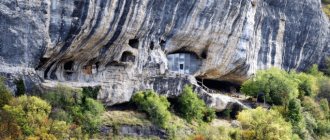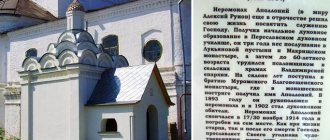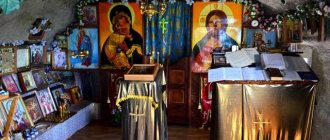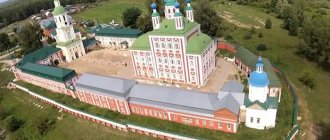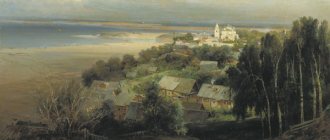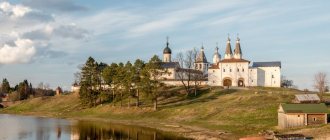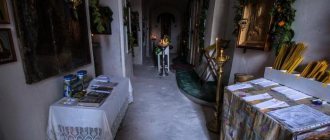Mir
Russia Nizhny Novgorod region Nizhny Novgorod Annunciation Monastery (Nizhny Novgorod) Map is loading…
{"format":"leaflet","minzoom":false,"maxzoom":false,"limit":50,"offset":0,"link":"all","sort":[""], "order":[],"headers":"show","mainlabel":"","intro":"","outro":"","searchlabel":"\u2026 \u0441\u043b\u0435\ u0434\u0443\u044e\u0449\u0438\u0435 \u0440\u0435\u0437\u0443\u043b\u044c\u0442\u0430\u0442\u044b","default":"","import-annotation":false,"width ":"auto","height":"350px","centre":{"text":"","title":"""link":"""lat":56.32360657000000259131411439739167690277099609375,"lon": 43.9774489400000021532832761295139789581298828125,"icon":""},"title":"","label":"","icon":"","lines":[],"polygons":[],"circles":[ ],"rectangles":[],"copycoords":false,"static":false,"zoom":8,"defzoom":14,"layers":["OpenStreetMap"],"image layers":[] ,"overlays":[],"resizable":false,"fullscreen":true,"scrollwheelzoom":true,"cluster":false,"clustermaxzoom":9,"clusterzoomonclick":true,"clustermaxradius":80, "clusterspiderfy":true,"geojson":"","clicktarget":"","showtitle":true,"hidenamespace":false,"template":"","userparam":"","activeicon": "","pagelabel":false,"ajaxcoordproperty":"","ajaxquery":"","locations":[{"text":"\u003Cb\u003E\u003Ca href=\"/palomnik/%D0% 91%D0%BB%D0%B0%D0%B3%D0%BE%D0%B2%D0%B5%D1%89%D0%B5%D0%BD%D1%81%D0%BA%D0%B8% D0%B9_%D0%BC%D1%83%D0%B6%D1%81%D0%BA%D0%BE%D0%B9_%D0%BC%D0%BE%D0%BD%D0%B0%D1% 81%D1%82%D1%8B%D1%80%D1%8C_(%D0%9D%D0%B8%D0%B6%D0%BD%D0%B8%D0%B9_%D0%9D%D0%BE %D0%B2%D0%B3%D0%BE%D1%80%D0%BE%D0%B4)\» title=\»\u0411\u043b\u0430\u0433\u043e\u0432\u0435\u0449\u0435\ u043d\u0441\u043a\u0438\u0439 \u043c\u0443\u0436\u0441\u043a\u043e\u0439 \u043c\u043e\u043d\u0430\u0441\u0442\u044b\u0440\u0 44c (\u041d\u0438\u0436\u043d \u0438\u0439 \u041d\u043e\u0432\u0433\u043e\u0440\u043e\u0434)\»\u003E\u0411\u043b\u0430\u0433\u043e\u0432\u0435\u0449\u043 5\u043d\u0441\u043a\ u0438\u0439 \u043c\u0443\u0436\u0441\u043a\u043e\u0439 \u043c\u043e\u043d\u0430\u0441\u0442\u044b\u0440\u044c (\u041d\u0438\u 0436\u043d\u0438\u0439\u041d \u043e\u0432\u0433\u043e\u0440\u043e\u0434)\u003C/a\u003E\u003C/b\u003E\u003Chr /\u003E\u003Ca href=\"/palomnik/%D0%A1%D0%B2% D0%BE%D0%B9%D1%81%D1%82%D0%B2%D0%BE:%D0%90%D0%BD%D0%BD%D0%BE%D1%82%D0%B0%D1 %86%D0%B8%D1%8F\" title=\"\u0421\u0432\u043e\u0439\u0441\u0442\u0432\u043e:\u0410\u043d\u043d\u043e\u0442\u0430\u0446\u0438\ u044f\"\u003E\u0410\u043d\u043d\u043e\u0442\u0430\u0446\u0438\u044f\u003C/a\u003E: »'\u0411\u043b\u0430\u0433\u043e\u0432\u0 435\u0449\u0435 \u043d\u0441\u043a\u0438\u0439 \u043c\u043e\u043d\u0430\u0441\u0442\u044b\u0440\u044c»' \u2014 \u0434\u0440\u0435\u0432\u04 3d\u0435\u0439\u0448\u0438 \u0439 \u043c\u043e\u043d\u0430\u0441\u0442\u044b\u0440\u044c \u0432 \u041d\u0438\u0436\u043d\u0435\u043c \u041d\u043e\u043 2\u0433\u043e\u0440\u043e\u0434 "" title":"\u0411\ u043b\u0430\u0433\u043e\u0432\u0435\u0449\u0435\u043d\u0441\u043a\u0438\u0439 \u043c\u0443\u0436\u0441\u043a\u043e\u0439 \u0 43c\u043e\u043d\u0430\u0441\ u0442\u044b\u0440\u044c (\u041d\u0438\u0436\u043d\u0438\u0439 \u041d\u043e\u0432\u0433\u043e\u0440\u043e\u0434)","link":"","lat": 56.32360657000000259131411439739167690277099609375,"lon":43.9774489400000021532832761295139789581298828125,"icon":""}],"imageLayers":[ ]}
56.323637; 43.977519
Russia, Nizhny Novgorod, Chernigovskaya street, 7A
Nizhny Novgorod, Nizhny Novgorod region 603001
Russia
Telephone.:
(831) 430-07-97, 430-09-17 (deputy), 437-00-68 (accounting), 430-09-12 (sewing workshops)
Email:
Annunciation Monastery
- the oldest monastery in Nizhny Novgorod, founded at the beginning of the 13th century. Belongs to the Nizhny Novgorod and Arzamas diocese of the Russian Orthodox Church.
History[[edit]h2>
The Nizhny Novgorod Annunciation Monastery is located on the high right bank of the Oka River, not far from its confluence with the Volga, and currently represents a majestic monastic ensemble of white stone churches. It is believed that it was founded in 1221 by the Holy Blessed Grand Duke George Vsevolodovich and St. Simon, Bishop of Vladimir during the founding of Nizhny Novgorod.
In 1229, the monastery was attacked by the Mordovian prince Purgas, was completely destroyed and burned by the pagan prince, and ceased its activities for more than a hundred years. In 1357, Nizhny Novgorod was visited by Metropolitan Alexy of Moscow, who was heading to the Golden Horde as a representative for the Russian land. After the successful completion of his visit to the Horde, the archpastor fulfilled his vow to revive the ruined monastery. Through the efforts of Metropolitan Alexy, the white-stone single-domed Church of the Annunciation was built in 1370 and consecrated in 1371 in the Nizhny Novgorod Annunciation Monastery. In the 17th century the temple was rebuilt. The main shrine of the monastery was the Korsun Icon of the Most Holy Theotokos, donated by St. Alexis to the brethren of the revived monastery. The image was of Byzantine work, brought by the Metropolitan from Moscow. During the years of Soviet power, the image was requisitioned. At present, his fate and whereabouts remain unknown.
Revived in the 14th century, the Annunciation Monastery began to grow and prosper. The Grand Dukes of Suzdal and Nizhny Novgorod granted him land holdings and supplied the inhabitants with everything they needed. Many secular and clergy donated monetary and property contributions to the establishment of this monastic monastery, becoming its patrons, defenders and benefactors.
Since the restoration of the monastery, it began to belong to the House of Metropolitans of Moscow, and with the establishment of the patriarchate in 1589, it was called the “house monastery of the Patriarchal House,” that is, stauropegial. The Russian high priests gave letters of grant to the Nizhny Novgorod Annunciation Monastery on their own behalf and asked for mercy from the monarchs for the monastery. Thus, during the reign of Archimandrites Ferapont II (1640–1649), Sergius (1651–1654) and Paphnutius (1660–1679), the Annunciation Monastery had many different benefits and advantages, enshrined in the corresponding charters. Being a kind of center for the dissemination of church culture and education, by the end of the 19th century the Annunciation Monastery had an extensive library in which handwritten and early printed books of the 16th-19th centuries were preserved.
The number of inhabitants living in the monastery in the 18th century, until the reform of 1764, was 5060 people. In 1764, by decision of the Holy Synod, the Annunciation Monastery was transferred to the direct management of the local diocesan bishop - the Bishop of Nizhny Novgorod and Arzamas. In connection with the establishment of states, the monastery was ranked in the third class, with abbots, however, replaced for the most part by archimandrites. Many outstanding shepherds emerged from the walls of the Annunciation Monastery. In the 19th century, two outstanding saints of the Nizhny Novgorod land labored in the Annunciation Monastery - Bishop Jeremiah (Soloviev) of Nizhny Novgorod and Archbishop Macarius (Mirolyubov). In the middle of the 19th century, the most significant event in the history of the monastery was the construction of the new Alekseevskaya Church (1837) and the new stone chapel (1847) in the name of St. Alexis, Metropolitan of Moscow, patron saint of the Annunciation Monastery. After their death, Saints Jeremiah (Soloviev, 1884) and Macarius (Mirolyubov, 1894) were buried in the Alekseevsky Church.
After the October Revolution, the Nizhny Novgorod Annunciation Monastery was closed in 1919. Gradually, various civil institutions and organizations settled within its walls. The residential premises housed a school named after M. Yu. Lermontov, as well as communal apartments for workers and employees. Warehouses and other outbuildings were used by the military department, placing convoy transport in them. On the territory of the monastery, boats were built, carriages were repaired, horses were shoed, etc. Only one small church remained at the disposal of believers in the name of the Apostle Andrew the First-Called. In 1922, under the pretext of helping the hungry, the most valuable liturgical objects were confiscated from the churches of the Annunciation Monastery - gold and silver vestments from icons, altar crosses, tabernacles, vessels, censers, lamps and much more. According to archival documents, the total weight of the 135 seized items was about 136 kilograms.
In 1923, on the basis of the official conclusion of the secular authorities, the stone over-chapel in the name of St. Alexis over the holy spring was destroyed as a dilapidated structure that did not represent any special architectural value.
In 1924, at the request of the parish council of St. Andrew's Church, which at that time was headed by Archimandrite Joseph (Kamenetsky), the monastery was accepted under the protection of the local Gubernia Museum. All its buildings were classified as the first category of monuments protected by the state, but these measures could not save the monastery from ruin. In 1928, the only St. Andrew's Church operating at that time was closed, and its property was transferred to the state. From that time on, all monastic buildings were finally nationalized and church life was interrupted. The few brethren and members of the clergy were evicted and subjected to various oppressions and persecutions.
In 1948, a planetarium was located in the Alekseevsky Church, and therefore the temple was partially rebuilt.
In 1960, the monastery ensemble as an architectural monument was taken under state protection, but all its buildings remained in a dilapidated state, without repair or reconstruction. In the 70–80s of the 20th century, partial restoration of some buildings of the Annunciation Monastery began, primarily the Annunciation Cathedral, which was damaged by the 1974 hurricane. In 1987, restoration work was completed.
The revival of the Annunciation Monastery began in 1991, when the ancient monastery was returned to the Nizhny Novgorod diocese. Church life resumed within the walls of the monastery, and divine services began to be held. September 25, 1993 is considered the official opening date of the monastery.
Temples and shrines
The complex includes several temples :
- Cathedral in honor of the Annunciation of the Blessed Virgin Mary.
- Church in honor of the Dormition of the Blessed Virgin Mary with a monastery refectory.
- Church in the name of St. Alexy, Metropolitan of Moscow.
- Temple in the name of St. Seraphim of Radonezh.
- Temple in the name of the Apostle Andrew the First-Called.
Shrines:
- Icon of the Mother of God "Korsun".
- Particles of the relics of saints in the ark.
- Icon with particles of the relics of St. Sergei of Radonezh.
The Korsun Icon of the Mother of God, painted in 993 by Hieromonk Simeon, is a copy brought in 988 by Saint Prince Vladimir from Korsun to Kyiv. During the fires, the holy icon remained unharmed.
The Annunciation Cathedral is the oldest five-domed stone building, created in 1647. The monastery suffered devastating fires, but the four-tiered ancient iconostasis and ancient paintings have been preserved here.
The Assumption Church looks like a tomb. The temple vault is crowned with stone tents, like flowers. The 4-meter-high sub-church housed a kitchen, bakery and storage rooms. The church is adapted for worship in winter.
St. Andrew's Church is located in the central part of the fraternal building. Here are the fraternal cells and the administration of the Annunciation Monastery.
Sergius Church was erected on the site of the old Annunciation Church and is hidden from prying eyes by the modern Annunciation Cathedral and the southern wall of the monastery. The church is decorated with brick platbands with torn pediments. The walls of the church were re-painted and a new iconostasis was made.
Alekseevskaya Chapel is a stone octagonal chapel next to the Gremyachiy Klyuch spring. Metropolitan Alexy stopped here on his way to the Golden Horde.
The bell tower is a stone tented belfry with 11 bells, the heaviest one is 123 pounds. In ancient times, a striking clock was installed on the belfry, which was damaged in a fire.
On the well-groomed territory there is a hospital building and a theological seminary building, as well as a worship cross on the site of the destroyed chapel, a monument to the Russian Emperor Alexander III. Below is the holy spring Gremyachiy Klyuch in the ravine.
The monastery has a monastery of the Mother of God, located in the forest, in honor of the icon “Inexhaustible Chalice” near the village of Rozhnovo, Bor district. In 2003, a temple was built here in honor of the icon of the Mother of God “The Inexhaustible Chalice”.
On the territory of the Annunciation Monastery there is a monastery shop where they sell Orthodox literature, editions of the Bible and the Holy Gospel with interpretation of texts, icons and chains, crosses and amulet. Here they serve notes of health and repose, and order funeral dinners. The shop sells blessed honey and milk brought from a monastery in the Bor region.
Current state[[edit]h2>
With the beginning of the restoration of the spiritual life of the monastery, the revival of spiritual education in the Nizhny Novgorod diocese also began. With the blessing of Metropolitan Nikolai (Kutepov) of Nizhny Novgorod and Arzamas, catechist courses were initially located within the walls of the Annunciation Monastery, and then the Nizhny Novgorod Theological Men's School, which was transformed into a theological seminary in 1995. Students of the Nizhny Novgorod Theological Seminary took an active part in the revival of the monastery, who performed various obediences in the monastery. The restoration and revival of the spiritual life of the Annunciation Monastery continues to this day.
In 2007, a porcelain iconostasis was installed in the restored Church of St. Alexis. There are porcelain iconostases in several churches in Moscow, on Valaam, and in Yekaterinburg. In Nizhny Novgorod, this is the first experience of installing such an iconostasis in a church.
On April 7, 2009, on the feast of the Annunciation, the icons of the forefathers' row of the unique ancient Russian iconostasis of the Annunciation Cathedral were consecrated; the icons depict the forefathers Abel, Isaac, Noah, Seth, Enoch and Abraham.
Since 2010, parishioners of the monastery have been helping to restore the Church of John the Baptist in the village of Prudishchi.
On May 7, 2011, Archbishop Georgy of Nizhny Novgorod and Arzamas consecrated the Church of St. Sergius of Radonezh.
On August 23, 2013, a bronze monument-bust to Emperor Alexander III (sculptor A. A. Appolonov) was solemnly opened on the territory of the monastery.
Skit “Inexhaustible Chalice”
Life in the world is complicated because a person is constantly exposed to various temptations. Unable to resist temptation, to experience difficulties and misfortunes, people sometimes commit unseemly acts or destroy themselves through drunkenness and other harmful addictions. In such cases, help is required, and it can be provided at the Annunciation Monastery in Nizhny Novgorod, or more precisely, at the “Inexhaustible Chalice” monastery.
The monastery is located in the countryside, in the building of a former military unit. People come here to pray before the icon of the Mother of God “The Inexhaustible Chalice” and to ask for help in healing from an illness.
Guests take care of cows, goats, poultry, and restore destroyed buildings. But the main thing for those who come is to rethink their lives, find the true causes of the problems that arise, and learn faith.
The destinies of people who left the monastery turn out differently, but they all connect their lives with God. This is how the Annunciation Monastery in Nizhny Novgorod helps the laity.
Shrines[[edit]h2>- Before the revolution, the monastery housed a revered copy of the Korsun Icon of the Blessed Virgin Mary. The inscription on the robe, made in two languages, Slavic and Greek, read: “This image was painted in the summer of 6501 (903) by Simeon the hieromonk.” When the monastery was destroyed, the list disappeared, although it had previously remained unharmed in three fires. Now in the iconostasis of the Annunciation Cathedral of the monastery there is a modern copy of the icon.
- Holy spring of St. Alexis, Metropolitan of Moscow
How to get to the monastery
The monastery is located in the Nizhny Novgorod region, on the right bank of the Oka River, not far from its mouth - near the Kanavinsky Bridge (Melnichiy Lane, 8). You can get to its territory by buses and minibuses (stops “Blagoveshchenskaya Square” or “Chernigovskaya Street”) or walk about 1.7 km from the Gorkovskaya metro station.
Attraction rating:
Rating 4.40 [5[5 Vote(s)]p>
| ← N.NOVGOROD | NIZHNY NOVGOROD REGION MONASTERIES OF N. NOVGOROD | RUSSIA → |
Periodicals
The Nizhny Novgorod Annunciation Monastery publishes the online magazine “Zdravnitsa”. The pages of the periodical publish the words of pastors, articles about memorable dates, pilgrimages to holy places, spiritual development of the individual, and raising children.
The materials are divided into sections according to the components of the Christian personality: spirit, soul, body.
The goal of the project is to promote the preservation of the moral health of the family and the development of the traditions of Orthodox culture by parishioners. The editorial board is headed by Archimandrite Alexander (Lukin), and Archbishop Luka of Crimea and Simferopol was chosen as the heavenly patron of the magazine.


